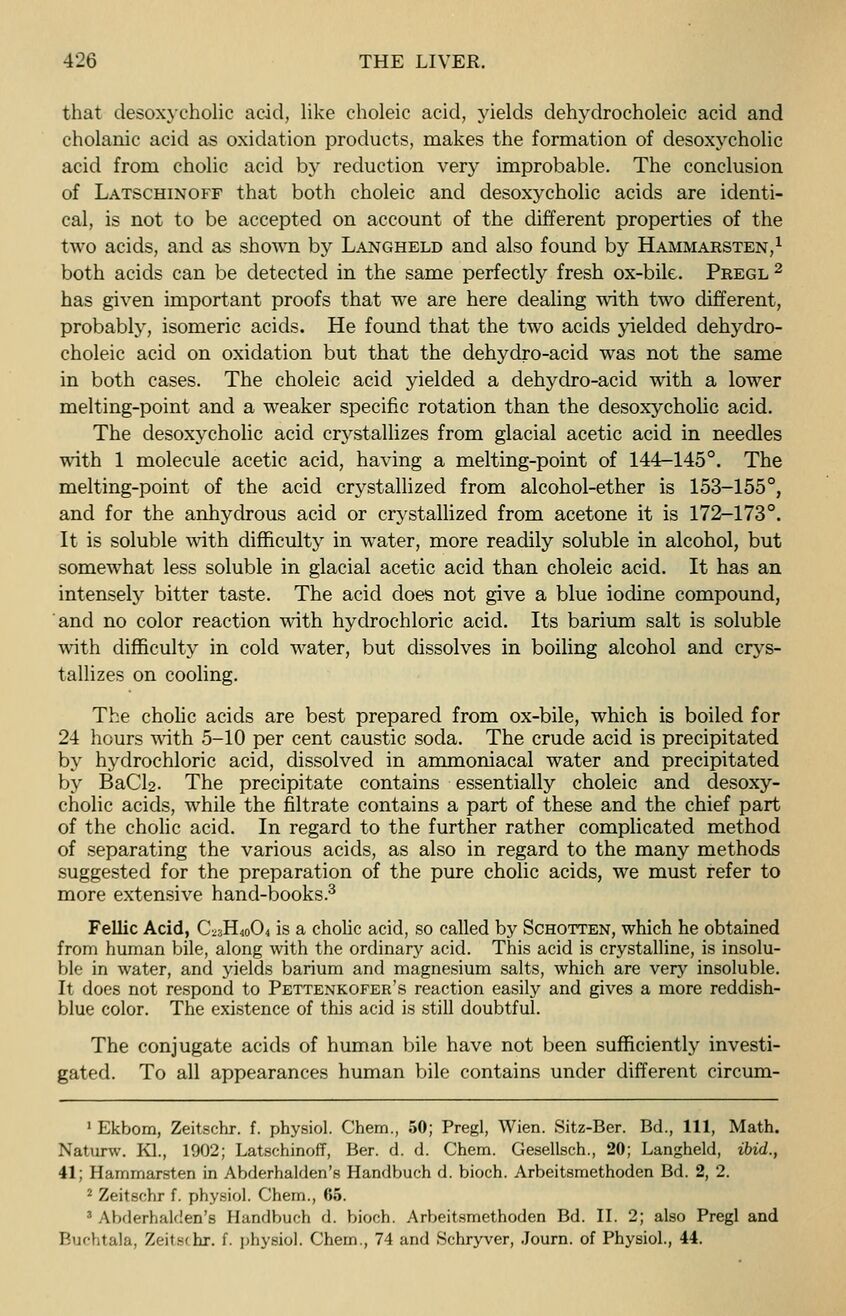
Full resolution (JPEG) - On this page / på denna sida - VII. The Liver - The Bile and its Formation

<< prev. page << föreg. sida << >> nästa sida >> next page >>
Below is the raw OCR text
from the above scanned image.
Do you see an error? Proofread the page now!
Här nedan syns maskintolkade texten från faksimilbilden ovan.
Ser du något fel? Korrekturläs sidan nu!
This page has never been proofread. / Denna sida har aldrig korrekturlästs.
426 THE LIVER.
that desoxycholic acid, like choleic acid, yields dehydrocholeic acid and
cholanic acid as oxidation products, makes the formation of desoxycholic
acid from cholic acid by reduction very improbable. The conclusion
of Latschinoff that both choleic and desoxj^cholic acids are identi-
cal, is not to be accepted on account of the different properties of the
two acids, and as shown by Langheld and also found by Hammarsten,1
both acids can be detected in the same perfectly fresh ox-bile. Pregl 2
has given important proofs that we are here dealing with two different,
probably, isomeric acids. He found that the two acids yielded dehydro-
choleic acid on oxidation but that the dehydro-acid was not the same
in both cases. The choleic acid yielded a dehydro-acid with a lower
melting-point and a weaker specific rotation than the desoxycholic acid.
The desoxycholic acid crystallizes from glacial acetic acid in needles
with 1 molecule acetic acid, having a melting-point of 144-145°. The
melting-point of the acid crystallized from alcohol-ether is 153-155°,
and for the anhydrous acid or crystallized from acetone it is 172-173°.
It is soluble with difficulty in water, more readily soluble in alcohol, but
somewhat less soluble in glacial acetic acid than choleic acid. It has an
intensely bitter taste. The acid does not give a blue iodine compound,
and no color reaction with hydrochloric acid. Its barium salt is soluble
with difficulty in cold water, but dissolves in boiling alcohol and crys-
tallizes on cooling.
The cholic acids are best prepared from ox-bile, which is boiled for
24 hours with 5-10 per cent caustic soda. The crude acid is precipitated
by hydrochloric acid, dissolved in ammoniacal water and precipitated
by BaCb. The precipitate contains essentially choleic and desoxy-
cholic acids, while the nitrate contains a part of these and the chief part
of the cholic acid. In regard to the further rather complicated method
of separating the various acids, as also in regard to the many methods
suggested for the preparation of the pure cholic acids, we must refer to
more extensive hand-books.3
Fellic Acid, C23H40O4 is a cholic acid, so called by Schotten, which he obtained
from human bile, along with the ordinary acid. This acid is crystalline, is insolu-
ble in water, and yields barium and magnesium salts, which are very insoluble.
It does not respond to Pettenkofer’s reaction easily and gives a more reddish-
blue color. The existence of this acid is still doubtful.
The conjugate acids of human bile have not been sufficiently investi-
gated. To all appearances human bile contains under different circum-
1
Ekbom, Zeitschr. f. physiol. Chem., 50; Pregl, Wien. Sitz-Ber. Bd., Ill, Math.
Naturw. Kl., 1902; Latschinoff, Ber. d. d. Chem. Gesellsch., 20; Langheld, ibid.,
41; Hammarsten in Abderhalden’s Handbuch d. bioch. Arbeitsmethoden Bd. 2, 2.
2
Zeitschr f. physiol. Chem., 65.
Vbderhalden’s Handbuch d. bioch. Arbeitsmethoden Bd. II. 2; also Pregl and
Buchtala, Zeitsfhr. f. physiol. Chem., 74 and Schryver, Journ. of Physiol., 44.
<< prev. page << föreg. sida << >> nästa sida >> next page >>